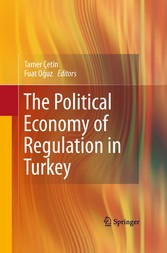Suchen und Finden
The Political Economy of Regulation in Turkey
3
Preface
5
Contents
7
Contributors
9
Chapter 1: Introduction: Regulation and Competition in Turkey
11
1.1 Regulatory Governance and Commitment
12
1.2 Competition or Regulation?
14
1.3 The Turkish Experience
16
1.3.1 A General Outlook
17
1.3.2 Lessons from the Markets
18
References
21
Chapter 2: The Place of Regulation Within the Public Law in Turkey
23
2.1 Introduction
23
2.2 How Does the Turkish Public Economic Law Perceive the Regulation?
23
2.3 The Constitutional Framework of the Regulation in Turkey
25
2.4 The IRA in Turkey
26
2.4.1 The Appearance of IRA in the Legal Environment
26
2.4.2 The Reactionary Points of the Conventional Administrative Structure Toward IRA
27
2.5 Conclusion
28
References
29
Chapter 3: The Political Economy of Privatization in Turkey: An Evaluation
30
3.1 Introduction
30
3.2 Historical Background
31
3.2.1 Interventionist State Policy and Establishment of SEEs
31
3.2.2 Liberal Economic Applications and Privatization Policies
38
3.3 Privatization Policy in Practice
40
3.3.1 Institutional and Legal Factors
43
3.3.2 Economic Factors
46
3.3.3 Political Factors
48
3.4 Conclusion
52
References
54
Chapter 4: Regulatory Diffusion in Turkey: A Cross-sectoral Assessment
58
4.1 Introduction
58
4.2 Varying Perspectives on the Diffusion of Regulatory Reforms
59
4.3 Regulatory Reforms in Turkey
62
4.3.1 Competition Authority
65
4.3.2 The Banking Regulation and Supervision Agency
67
4.3.3 Information Technology and Communications Authority10
68
4.3.4 Energy Market Regulatory Authority
70
4.3.4.1 Regulation of the Electricity Industry
71
4.3.4.2 Regulation in the Gas Industry
72
4.3.5 Anomalies in Regulation: Turkish NRAs in Unusual Sectors
73
4.3.5.1 Sugar Agency
74
4.3.5.2 Tobacco and Alcohol Market Regulatory Agency
76
4.4 Conclusion
77
References
78
Chapter 5: The Legal Structure of Competition Policy in Turkey
81
5.1 Introduction
81
5.2 Background and the Sources of the Antitrust Law
82
5.3 Main Concepts
84
5.3.1 Scope of Application
84
5.3.1.1 Relevant Market
85
5.3.1.2 Territorial Reach
86
5.3.1.3 Special Industries
87
5.3.2 Undertakings and the Associations of Undertakings
90
5.4 Overview of Substantive Provisions
92
5.4.1 Restrictive Agreements
92
5.4.1.1 Collusive Behavior
92
The Agreement
93
Concerted Practices
93
Decisions of Associations of Undertakings
94
5.4.1.2 Test of Illegality: Restriction of Competition
95
Horizontal and Vertical Restraints
95
Per Se Prohibitions and Rule of Reason
95
Leniency
97
5.4.1.3 Exemption
98
5.4.2 Abuse of Dominant Position
98
5.4.2.1 Dominant Position
99
5.4.2.2 The Concept of Abuse
102
Exploitative Abuses
103
Exclusionary Abuses
105
Concentrations
109
The Concept of Concentration
109
Merger Test: Creating or Strengthening Dominance and Thereby Lessening Competition
111
Procedural Issues
113
5.5 Consequences of Violations and Enforcement Institutions
115
5.5.1 Administrative Enforcement
115
5.5.1.1 The Turkish Competition Board
115
Formation and Composition
115
Investigative Powers
116
5.5.1.2 Administrative Fines
118
5.5.1.3 Administrative Injunctions
119
5.5.1.4 Interim Measures
119
5.5.2 Civil Enforcement
119
5.5.2.1 Nullity
120
5.5.2.2 Damages
121
5.6 Conclusion
124
References
125
Chapter 6: Regulation in the Turkish Electricity Industry
128
6.1 Introduction
128
6.2 Reform in the Turkish Electricity Industry
129
6.2.1 Historical Development of Market Structure
129
6.2.2 Present Structure of the Turkish Electricity Industry
132
6.2.3 Current State of Privatization in Distribution Companies
133
6.3 Regulatory Framework for the Turkish Electricity Industry
135
6.3.1 Composition and Regulation of End Users’ Tariff
135
6.3.2 Determination of Revenue Requirements2
136
6.3.3 Incentive Regulation in Turkish Electricity Distribution
138
6.3.4 Service Quality Measures
138
6.3.5 Reward/Penalty Schemes for Service Quality
140
6.4 An Application of DEA on the Turkish Electricity Distribution Industry
141
6.4.1 DEA Methodology in a Nutshell
141
6.4.2 Data, Variables, and Findings
143
6.5 Conclusion
145
References
146
Chapter 7: The Regulation of Natural Gas Industry in Turkey*
149
7.1 Introduction
149
7.2 Background to Turkish Natural Gas Market
152
7.3 General Regulatory Framework in Turkish Natural Gas Market
156
7.4 Turkish Gas Release Program
159
7.5 The Auctions in Turkish Gas Distribution Market
160
7.5.1 Theoretical Foundations
160
7.5.2 Auctions in Practice
163
7.6 Turkish Reforms Within EU Framework
172
7.7 Discussion and Guidelines for Policy Makers
175
7.8 Conclusion
178
References
179
Chapter 8: Regulation and Competition in the Turkish Telecommunications Industry
181
8.1 Introduction
181
8.2 General Background and the New Legal Framework
181
8.3 Developments in Major Segments
185
8.3.1 Competition and Regulation: Fixed Versus Mobile
185
8.3.2 Developments in Fixed Telephony
186
8.3.3 Developments in Broadband
188
8.3.4 Developments in the Mobile Segment
190
8.3.4.1 Retail and Wholesale Tariff Controls
191
8.3.4.2 Mobile Number Portability
192
8.3.4.3 Mobile Call Termination Rates
192
8.4 Conclusion
194
References
194
Chapter 9: Regulation, Deregulation, and Competition in the Turkish Airline Industry
196
9.1 Introduction
196
9.2 Historical Setting
197
9.2.1 Regulatory Institutions in the Industry
198
9.2.1.1 DGCA
199
9.2.1.2 GDSAA
199
9.2.2 The Relevant International Institutions
200
9.2.2.1 ICAO
200
9.2.2.2 EUROCONTROL
201
9.2.3 Privatization Attempts and the Build-Operate-Transfer Model
201
9.3 The Pre-2003 Industry Structure
202
9.3.1 Barriers to Entry
202
9.3.2 Pricing Policy and Potential Competition
204
9.4 The Post-2003 Market Structure: Results of Deregulation
205
9.4.1 Entry and Route Restructure
205
9.4.2 Other Developments
208
9.4.3 Quality of Service and Ground Handling
212
9.4.4 Turkish Airlines as a Monopoly Power in the Industry
213
9.5 Conclusion
216
References
216
Chapter 10: Political Economy of Water Regulation and the Environment in Turkey
218
10.1 Introduction
218
10.2 Endowments
219
10.3 Forces Driving Water Policies
222
10.4 Institutions and Organizations
225
10.5 Environmental Laws and Organizations
230
10.6 Water Consumption and Irrigation Development
232
10.7 Environmental Effects
238
10.7.1 Aksehir Gölü
239
10.7.2 Tuz Gölü
239
10.7.3 Beysehir Gölü
240
10.7.4 Seyfe Gölü
240
10.7.5 Avlan Gölü
241
10.8 Conclusion
243
References
244
Index
249
Alle Preise verstehen sich inklusive der gesetzlichen MwSt.



















